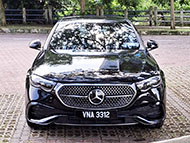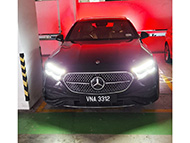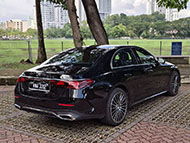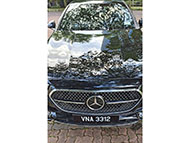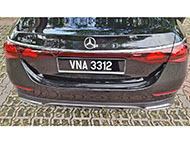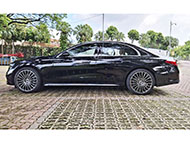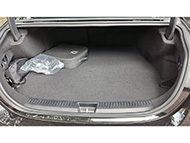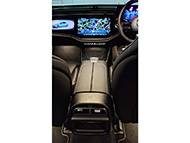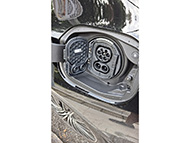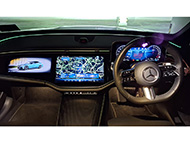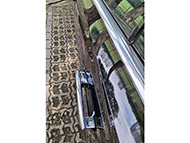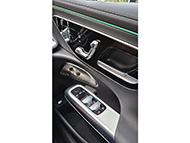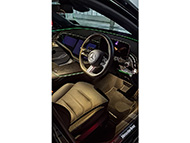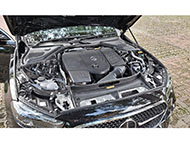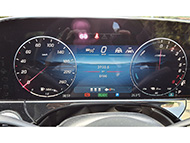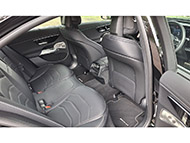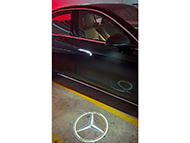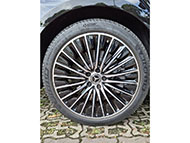By Lee Pang Seng
BETTER connectivity is the key word in new cars these days, influenced no doubt by the increased rollout of electric vehicles (EVs) that feature this. It has come to the point that the internal combustion engine (ICE) cars are also adopting design elements from EVs as well.
That was the general impression we had after driving the latest Mercedes-Benz E 350 e, which is a plug-in hybrid sedan, over a weekend. The flushed door handles, so common in EVs, was our first introduction to the E 350 e when we pressed the Open button on the keyfob.
As we entered the executive sedan, we couldn’t help believe that we were entering one of the EV cars in the Mercedes-Benz stable. The clean, minimalist layout of the dashboard and the wide info-display screen running from left to right reinforces the visual impact even more.
We were told that to enjoy the full range of controls and conveniences in the E 350 e, we had to download dedicated Mercedes apps to access them. As we have one app too many on our handphone, we decided to make do with what was manually available or via the touchscreen access on the centre info display.
The other part of the EV impression came about when we spent the first day after collecting the E 350 e doing errand runs in KL on electric power. As a plug-un hybrid or PHEV (plug-in hybrid electric vehicle), it could fulfil its EV role better with a high voltage battery and that’s just what the E 350 e is provided with.
The new battery is developed in-house and is part of a fourth-generation family of batteries. Mercedes says it has 96 cells in a pouch configuration and its energy content is 25.4kWh, of which 19.5kWh is available for electric operation. As a high-density high-voltage battery, it has an internal cooling system.
This high-voltage battery gives the electric motor a geater output of 95kW (129hp) and 440Nm peak torque that is available immediately on taking off. This also improved the electric range up to 118km (WLTP – Worldwide Harmonised Light Vehicle Test Procedure) that gave us almost one day of electric driving.
And if one were to charge the battery by up to 80 per cent when the level falls, an E 350 e owner probably won’t have to use any petrol at all. In our case, we could have charged the E 350 e when the battery level was depleted as the condo we stay at had three DC chargers installed recently. Again, you need an app to use the chargers and we weren’t keen on downloading another app for which we have little use of other than when taking PHEVs or EVs for drive impressions.
The energy recovery function is about as good as that for an EV. You could determine the rate of recovery in all drive modes except Sport. The kinetic energy is recuperated during braking or downhill driving although we couldn’t quite do enough to ‘charge’ the battery up even by a quarter level.
We noted this through the tachometer that displayed the battery level at the bottom of the dial. To the left is the kinetic energy display (green for recovery and blue for power use during acceleration) and to the right is the tachometer with an indicator needle that came alive when the engine was activated to power the car.
Each time we came to a stop, at the traffic lights or junctions, the engine would be switched off. The take-off would be on electric mode before the engine cuts in, depending on how much energy was recovered during braking before stopping.
The E 350 e’s engine is a 2.0-litre (1999cc) turbocharged unit that develops 150kW (204hp) at 6100rpm and 320Nm from 2000 to 4000rpm. With the combined power (electric motor and engine), the rated output is 230kW (313hp) and 550Nm. The high torque output gives the E 350 e an impressive 0-100km/h sprint in 6.4 seconds and a top speed of 236km/h.
If we wanted to accelerate hard for fast overtaking, the turbo kicked in to give us that quick get-up-and-go performance. On highway drives, the engine would be doing most of the work although energy recuperation would still occur when we hit the brakes and drove on downhill sections.
The interior ambience is made rather colourful and engaging by the latest MBUX Superscreen.to make its EV character even more striking. There is a glass contour strip that changes colour from a pleasant shade of green to other hues. It even turned red in tandem with the car’s Active Brake Assist function when it detected that we were approaching another vehicle from the rear a bit too quickly.
And if we were to ignore that ‘red warning’, the driver’s seatbelt would be activated in a pulsating way to let us know that a collision was imminent if we did not slow down sufficiently. It sure got our attention after it happened a couple of times and we did slow in subsequent instances to avoid the seatbelt vibrating against our chest!
You couldn’t be safer driving the new E 350 e with its long list of active and passive safety features, including the 360-degree view that comes up so clearly on the 14.4-inch centre display to guide you in tight spots. And if one were to download the Mercedes me app, the Hey Mercedes voice assistant is said to be highly capable of dialogue and learning.
Creature comfort includes the Burmester 4D surround sound system with 21 speakers, leather upholstered seats with intricate longitudinal fluting, climatised front seats with three-stage ventilation and heating, panoramic sliding sunroof with many detailed improvements made to the wind deflector and the addition of side wind deflectors to the glass roof, among others.
We also noted a camera located on the dashboard and had the dreadful feeling that we were being watched and monitored. That’s what it’s supposed to do as it records our eye movements to ensure that we are not distracted as a driver, especially by the rather large passenger screen. It would even reduce the brightness of the passenger screen if it detects that the driver might be potentially distracted by the graphic content there.
The new E Class might not impress one immediately on being aerodynamic efficient in body profile probably because it has a bigger frontal area against the previous model. But efforts in the wind tunnel have achieved the same aerodynamic co-efficient (Cd) of 0.23 to be on par with the previous E Class.
This was made possible with optimised body contours (including the tyres), innovative sealing of the front section (Mercedes says the side sealing of the bonnet and an aero-lip in the radiator grille are being applied for the first time), wheels with claddings (aeroblinds), special spoilers at front and rear wheels, new materials for the improved shaped underbody and of course, the flush door handles.
These improvements certainly made our highway drives a lot quieter and more comfortable, which should appeal to the potential clientele that the E Class sedans pander to. We were equally at home driving the E 350 e through winding stretches at fair speeds as the car appeared dynamically sound with good suspension design and assist systems.
Being a PHEV, the E 350 e comes fitted with Michelin e-Primacy tyres of the size 275/35 R 20 that are normally designed for EVs. It took to all manners of tarmac road conditions well, absorbing the harsh impacts and bumpy irregularities to add nicely to overall ride comfort. This included keeping road noise to the minimum, despite the varying types of road surfaces.
There appears to be no shortage of lounge room for rear passengers too. The new E Class continues the ‘classic three-box’ sedan styling with short front overhang and long bonnet. This ‘cab-backward’ design combines well with the slightly longer wheelbase of 2961mm (almost 30mm longer) to achieve that spacious passenger quality.
Having a C Class in our garage, we might seem partial to our impression of the latest E Class but we certainly enjoyed our weekend drive impression with it; whether it was in driving all over KL to do errands on electric power or going for lunch by driving along the winding stretch to Ulu Yam.
Priced at RM418,888 on the road without insurance, the Mercedes-Benz E 350 e is a premium class plug-in hybrid sedan that gives its targeted clientele a cost-effective ownership with its good electric mileage. That sounds like a good deal for the senior executive class.

